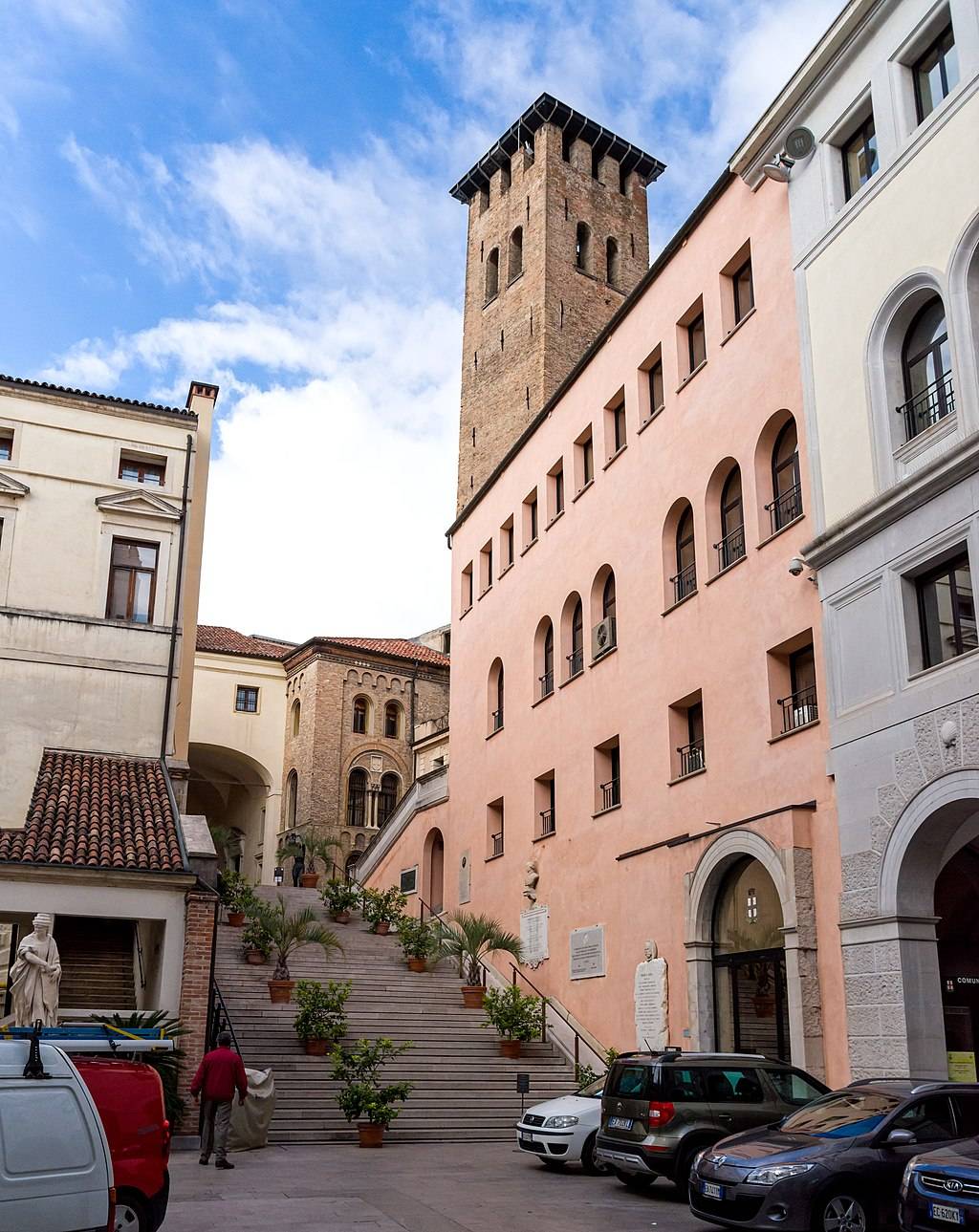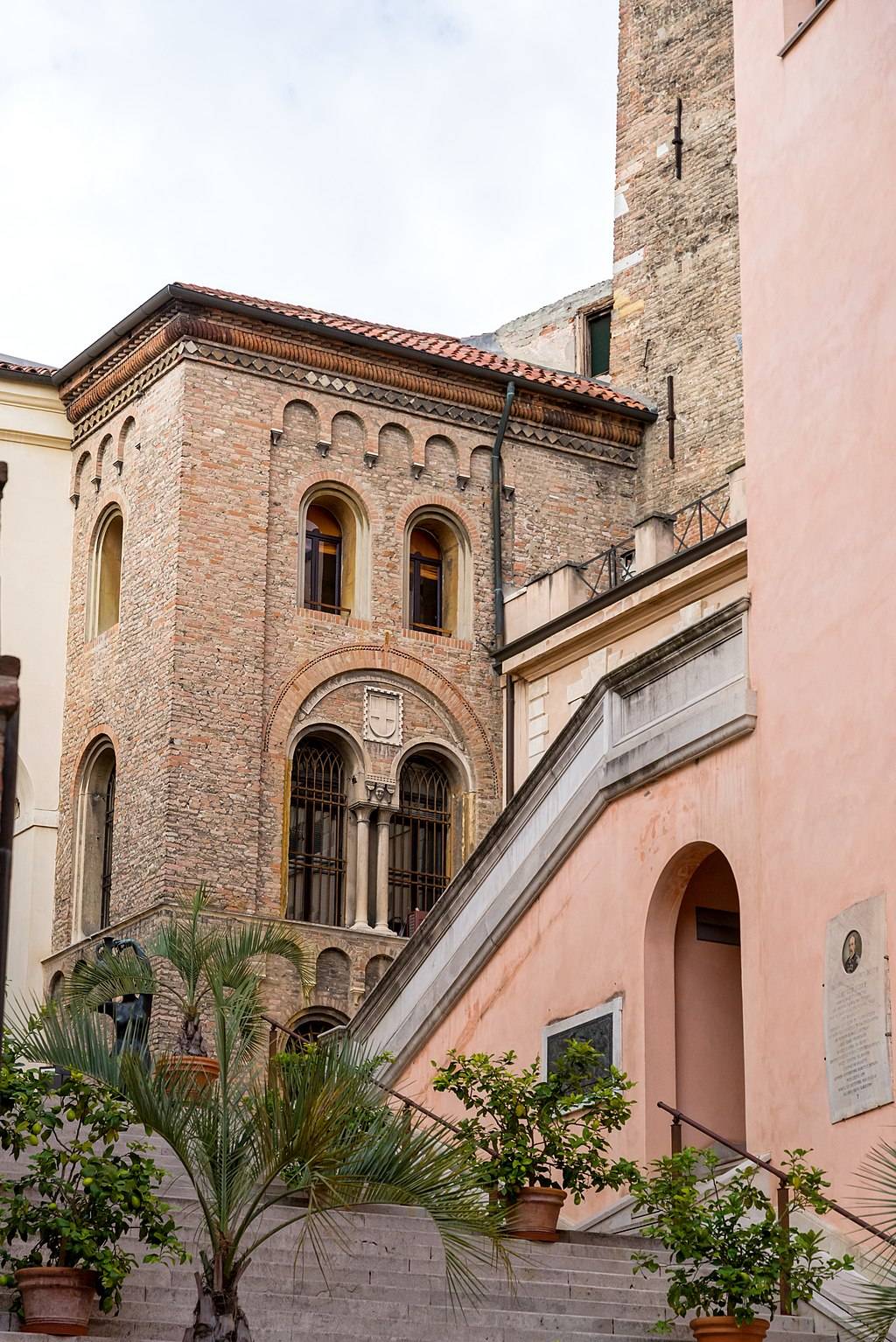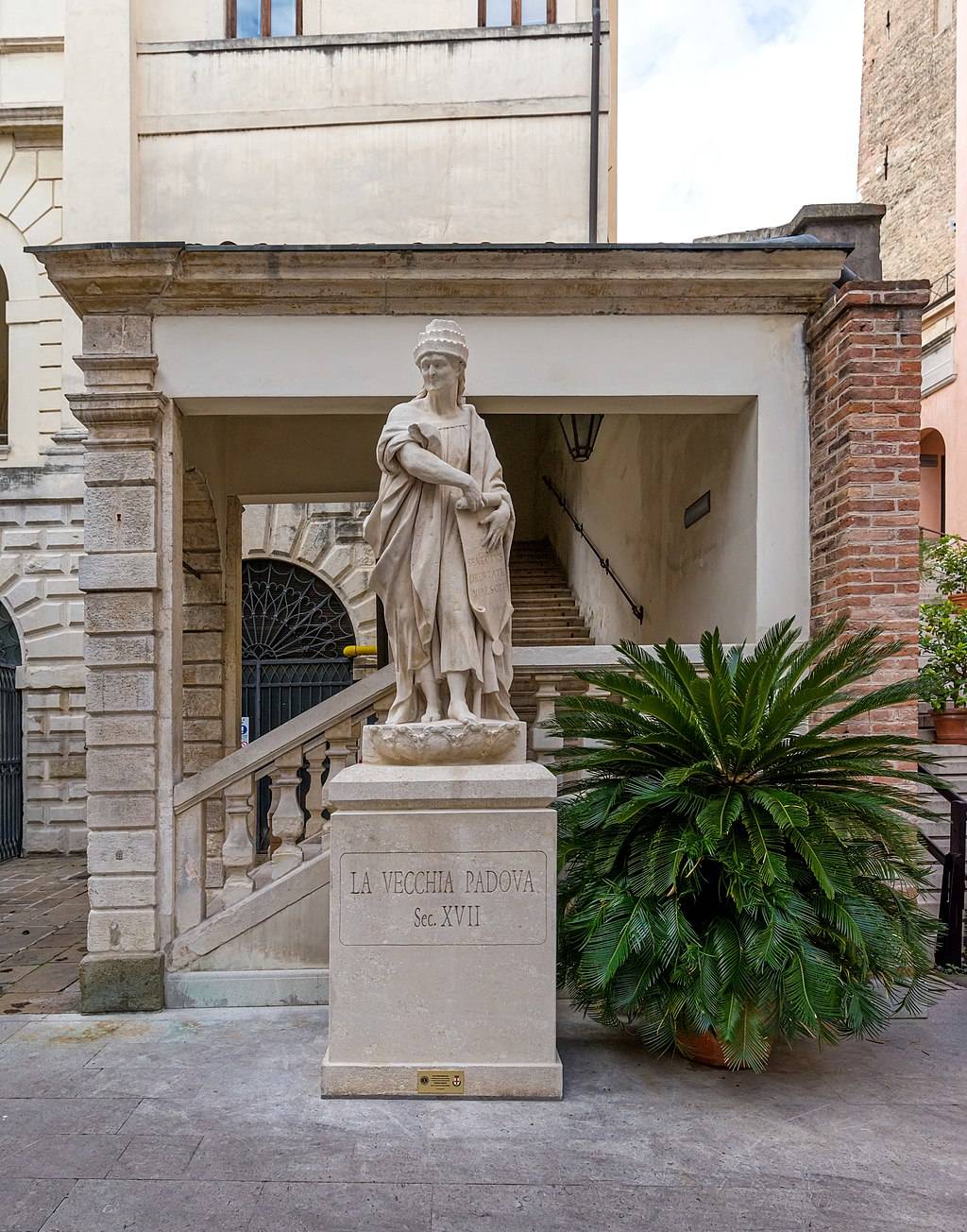Palazzo Moroni Via del Municipio, 1, Padua (PD), Veneto, Italy
Palazzo Moroni
Palazzo Moroni, the usual name for the Municipal Buildings, is a complex of buildings in the city’s heart that house the offices of the Municipality of Padua.

The imposing building complex overlooking Piazza delle Erbe is connected to the Palazzo della Ragione through the Volto della Corda while the main entrance is opposite the Palazzo Bo. It consists of a series of buildings: the sixteenth-century Palazzo Moroni, which gives its name to the whole complex, the medieval Palazzo del Consiglio and Palazzo degli Anziani, separated by the Torre degli Anziani, and the Moretti-Scarpari wing, built between the two World Wars as a monumental entrance to the Town Hall. The famous Palazzo della Ragione, which until the end of the 18th century maintained its functions as a town hall and palace of justice, and the Torre degli Anziani are part of the complex.
Palazzo Moroni or Palazzo del Podestà
Palazzo del Podestà was built in the thirteenth century as the representative residence of the chief magistrate in the medieval Paduan municipality, the podestà.
The building was damaged over the centuries by numerous fires; thus, in 1539 was rebuilt based on a project by the Bergamo architect Andrea Moroni, from whom it later inherited the name.
Whilst the works continued until the early 1600s, the Audience Hall was finished in 1554, and in 1595 was completed the hanging courtyard, which is located on the first floor and reachable by two symmetrical stairs. The courtyard has a four-sided portico with stone arches adorned with Doric columns and in the centre has a well from the sixteenth century.
Palazzo Moroni faces Piazza delle Erbe with two fronts and one side towards Palazzo del Bo, now hidden by the subsequent construction of the Moretti-Scarpari wing. The current appearance dates back to 1963 with the construction of the grand staircase located between the Palazzo del Podestà and the Palazzo degli Anziani, connecting the complex’s buildings.
The facade towards Palazzo della Ragione is adorned with the statue of Justice, sculpted by Tiziano Minio in 1552. Above the corner of the building is a 2-meter high obelisk, removed after the 2012 earthquake and relocated in May 2015.
The Noble Floor has three rooms of great charm:
The Sala del Consiglio or Council Chamber, also known as the Main Hall, is a large rectangular room with two opposing stone portals, above which there are the coats of arms of the city, a Venetian terrazzo floor and a wooden coffered ceiling with faux beams. Eight portraits from the seventeenth century of Roman emperors and empresses decorate the walls.
One of the two portals of the Sala del Consiglio connects to the Sala della Giunta or Junta Chamber, once called the Audience Hall of Podestà. It is a rectangular room that enjoys a splendid view of Piazza delle Erbe. It is enriched by a wooden ceiling covered with painted beams with a floral motif. A seventeenth-century painting entitled Saint Anthony blesses the Paduan territory is on the southern wall.
The Chapel of the Collegio dei Nodari is dedicated to Saint John the Baptist. Domenico Campagnola decorated it with the frescoes of the Stories of the Baptist on the walls and an altarpiece dedicated to the Virgin. The chapel, restored in 2009, now houses the Press Office of the Municipality.
Palazzo degli Anziani
The Palace of the Elders extends along Via Guglielmo Oberdan up to the 13th century Torre degli Anziani. It was the seat of the Council of Elders, made up of representatives of the guilds and the people.
After the suppression of the Council in the Venetian age, the building was used as the seat of the Vicar and was therefore called "the Vicariate".
The terracotta building stands on an elegant loggia built in white stone. The asymmetrical arches include bas-relief engravings of the city’s coat of arms and the mayor’s Guglielmo Malaspina degli Obizzi. He commissioned the first major restoration of the building in 1295. Under the loggia were the salt dealers, the offices of the tax collectors and customs officers.
The floors above the loggia are characterised by an order of small windows framed by hanging arches on the first floor and large mullioned windows on the upper one. The Council of Elders met in the large room on the third floor.
Torre degli Anziani
The Tower of the Elders is a medieval civic tower rising between Via Oberdan and Piazza della Frutta. It is the highest tower in Padua at 47 meters.
It was called the White Tower to distinguish it from the nearby Red Tower, demolished at the beginning of the 14th century to make the aerial passage above the Volto della Corda, which connects the Palazzo degli Anziani with Palazzo della Ragione.
The Tower was raised in 1295 to house a bell brought to the city as spoils of war.
In the seventeenth century, the tower’s roof was replaced by a monumental lantern surmounted by a dome on which the statue of Justice rested. A baroque marble balustrade surrounded the new top. The heavy elevation perhaps weighed on the tower’s stability, and in 1941 all of these additions were removed as part of an ample project of preservation of the tower. Once the lantern was removed, the tower’s height passed from 56.7 to 47 meters.
Palazzo del Consiglio
The Council Palace extends in the eastern corner of the complex and overlooks Piazza della Frutta.
It was built in the thirteenth century by Leonardo Bocaleca on a previous building belonging to the noble family of the Composampiero, one of the ruling families of Padua, but it was remodelled several times due to the fires that occurred in the following centuries.
The ground floor loggia is built in trachyte and white stone, divided into three parts by two elegant marble columns supporting two capitals dating back to the seventh century.
Since 1772 the loggia has been closed and occupied by shops, including the ancient apothecary Ai due catini d'Oro, one of the oldest active shops in the city. Opened during the eighteenth century as an apothecary, the original sign is still preserved inside, a scale with two gold basins. The current arrangement of the display case and shelves dates back to 1841.
There are three terracotta floors above the loggia, the last of which is opened by three elegant mullioned windows, which rest on a frame of hanging arches and end with a diamond-shaped terracotta frame, which crowns the building.
The Palazzo del Consiglio is connected to the Palazzo della Ragione through the Volto della Corda, an air link built in the fourteenth century.
Moretti-Scarpari wing
The Moretti-Scarpari wing overlooks Via 8 Febbraio, in front of the Palazzo del Bo, and represents the monumental entrance to the complex.
Romeo Moretti and Giambattista Scarpari designed it in 1919 to connect the Palazzo del Podestà with the Palazzo degli Anziani, but it remained unfinished.
The construction takes up the style of the Palazzo del Podestà, with the facade interrupted by a Renaissance-style tower, inspired by the Clock Tower, surmounted by a bronze statue representing the winged Victory, the work of Gaetano Samoggia.
The external walls are decorated with some statues that recall the First World War. On the facade, there is a tablet with the Bollettino della Vittoria of General Diaz that announced on 4 November 1918 the victory of the Kingdom of Italy in World War I, as well as an inscription that recalls the names of the fallen. Above the facade are the allegorical statues of Discipline, Work, Wisdom and Value.
In the centre is the door that leads into the Cortile d'Onore, surrounded on three sides by a portico, which has remained unfinished.
Palazzo delle Debite
The Palace of Debts is a neoclassical style building on the west side of the Piazza delle Erbe. It was built in 1874 on a project by Camillo Boito.
It was raised in the place of a building built in the thirteenth century to house the city prisons, called Prison of Debts, which remained in operation until the nineteenth century. The palace was connected to the Palazzo della Ragione through an overpass named Volto delle Debite, demolished when the new palace was built.
The current Palazzo delle Debite has recently undergone important restoration work and is awaiting an intended use.
Notes
The complex of municipal buildings is accessible from Via 8 Febbraio and the gate of Via del Municipio.
The public relations office is located on the ground floor of the Palazzo degli Anziani, on the north side of the courtyard of honour (it also has an entrance from Via Oberdan).
The municipal offices do not provide for tourist visits but are open to the public for events, exhibitions or demonstrations.
We welcome all contributions, no matter how small. Even a spelling correction is greatly appreciated.
All submissions are reviewed before being published.
Continue to changelog-

© 'Palazzo Moroni' by joergens.mi is licensed under CC BY-SA 4.0 Attribution copied to clipboard Failed copying attribution to clipboard -

© 'Palazzo Moroni' by joergens.mi is licensed under CC BY-SA 4.0 Attribution copied to clipboard Failed copying attribution to clipboard -

© 'Photo' by joergens.mi is licensed under CC BY-SA 4.0 Attribution copied to clipboard Failed copying attribution to clipboard -

We welcome all contributions.
All submissions are reviewed before being published.
We welcome all contributions, no matter how small. Even a spelling correction is greatly appreciated.
All submissions are reviewed before being published.
Continue to changelogWe welcome all contributions, no matter how small. Even a spelling correction is greatly appreciated.
All submissions are reviewed before being published.
Continue to changelogWe welcome all contributions, no matter how small. Even a spelling correction is greatly appreciated.
All submissions are reviewed before being published.
Continue to changelogCategory
Cost
-
52 m
Caffè Pedrocchi, one of the symbols of modern Padua, a café with historical prominence recognized for its coffee and good food
-
70 m
The Palazzo del Bo in Padua is a fifteenth-century complex and the historic seat of the University of Padua, one of the oldest universities in the world.
-
One of the oldest churches in the city, also popularly known as the Church of Santa Rita, it is historically a place of faith and meditation.
-
106 m
Piazza delle Erbe, one of the two squares that embrace the Palazzo della Ragione, is the temple of the Spritz cult and one of the most popular socializing places in Padua.
-
118 m
A true miracle of architectural audacity and an impressive collection of fourteenth-century mural paintings, the only secular and civil commission executed by Giotto in Padua



